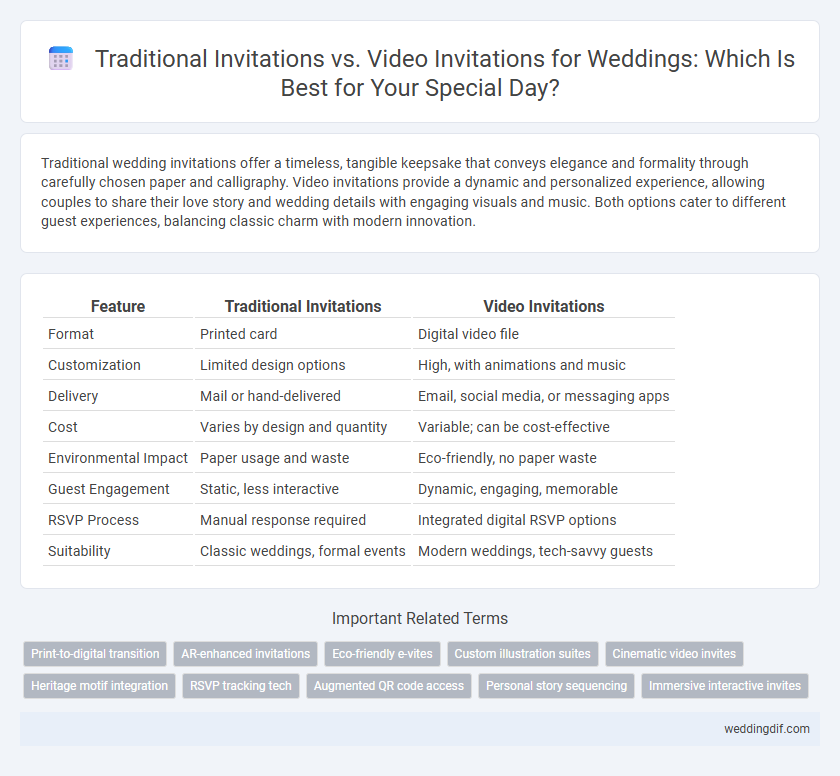Traditional wedding invitations offer a timeless, tangible keepsake that conveys elegance and formality through carefully chosen paper and calligraphy. Video invitations provide a dynamic and personalized experience, allowing couples to share their love story and wedding details with engaging visuals and music. Both options cater to different guest experiences, balancing classic charm with modern innovation.
Table of Comparison
| Feature | Traditional Invitations | Video Invitations |
|---|---|---|
| Format | Printed card | Digital video file |
| Customization | Limited design options | High, with animations and music |
| Delivery | Mail or hand-delivered | Email, social media, or messaging apps |
| Cost | Varies by design and quantity | Variable; can be cost-effective |
| Environmental Impact | Paper usage and waste | Eco-friendly, no paper waste |
| Guest Engagement | Static, less interactive | Dynamic, engaging, memorable |
| RSVP Process | Manual response required | Integrated digital RSVP options |
| Suitability | Classic weddings, formal events | Modern weddings, tech-savvy guests |
Introduction to Wedding Invitation Trends
Wedding invitation trends increasingly blend classic charm with modern technology, as traditional paper invitations remain cherished for their tactile elegance while video invitations offer dynamic storytelling and instant sharing capabilities. Couples seeking personalization and convenience favor video invitations for their ability to showcase personalities and details through multimedia elements, enhancing guest engagement. The choice reflects evolving preferences where timeless artistry meets innovative communication, reshaping how wedding celebrations are announced.
Defining Traditional Wedding Invitations
Traditional wedding invitations typically consist of printed cards featuring formal language, elegant typography, and classic designs that reflect the couple's style and the event's tone. These invitations often include details such as the date, time, venue, and RSVP instructions, and are usually sent through postal mail to convey a sense of timelessness and personal touch. Their tangible nature and cultural significance make them a favored choice for couples valuing tradition and formality in their wedding celebrations.
Understanding Video Wedding Invitations
Video wedding invitations offer a dynamic and personalized alternative to traditional paper invitations, enhancing guest engagement through multimedia elements like music, animation, and personalized messages. They provide the convenience of easy sharing via email or social media, reducing costs associated with printing and postage while allowing real-time RSVPs. By combining visual storytelling with interactive features, video invitations create a memorable first impression that reflects the couple's unique style and wedding theme.
Cost Comparison: Paper vs Video Invitations
Traditional paper wedding invitations typically cost between $2 and $10 per card, depending on design complexity and printing methods, while video invitations can range from $100 to $500 based on customization and production quality. Paper invitations incur additional expenses such as postage, envelopes, and address printing, often leading to a total cost per invitation that exceeds the base price. Video invitations eliminate postage costs and allow for unlimited digital distribution, making them a cost-effective option for couples seeking budget-friendly alternatives without sacrificing personalization.
Personalization and Creativity in Invitations
Traditional invitations often showcase personalized calligraphy and embossed details, reflecting cultural heritage and timeless elegance in wedding announcements. Video invitations offer dynamic creativity, incorporating customized music, animations, and personalized messages that engage guests on an emotional level. Both formats enhance personalization, but video invitations provide an interactive experience that traditional methods cannot match.
Environmental Impact: Eco-Friendly Choices
Traditional wedding invitations often rely on paper production, ink, and transportation, contributing to deforestation and carbon emissions, while video invitations offer a more eco-friendly alternative by reducing paper waste and minimizing physical delivery. Video invitations also decrease the consumption of resources associated with printing and mailing, making them a sustainable choice for environmentally conscious couples. Choosing digital invitations supports carbon footprint reduction and aligns with green wedding initiatives focused on sustainability and waste reduction.
Guest Experience and Accessibility
Traditional wedding invitations provide a tangible, elegant keepsake that guests can cherish, often featuring intricate designs and personalized calligraphy to enhance the physical experience. Video invitations offer dynamic storytelling with visuals, music, and voiceovers, making it easier to convey detailed event information and emotional tone, which is particularly accessible for guests with visual impairments through audio narration. Accessibility plays a crucial role as video invitations can include subtitles, sign language interpretation, and can be replayed on various devices, ensuring a broader reach and inclusivity compared to physical invitations that may be lost or overlooked.
Distribution and RSVP Management
Traditional wedding invitations rely on postal services for distribution, which may result in longer delivery times and manual RSVP tracking via phone or mail. Video invitations offer instant digital delivery through email or social media platforms, enabling real-time RSVP management and automated reminders. This digital approach enhances convenience and accuracy in managing guest responses compared to the slower, more labor-intensive process of traditional invitations.
Cultural and Etiquette Considerations
Traditional wedding invitations uphold cultural heritage and formal etiquette by reflecting customary designs, language, and rituals that resonate with family expectations and regional norms. Video invitations offer a modern alternative but may challenge traditional etiquette, especially in cultures valuing formal printed invites or requiring physical keepsakes for rituals. Selecting between traditional and video invitations depends on balancing respect for cultural customs with contemporary communication preferences, ensuring the invitation aligns with guests' expectations and social protocols.
Choosing the Right Invitation for Your Wedding
Traditional wedding invitations offer a timeless and formal touch, often crafted with high-quality paper and elegant typography that reflects the couple's style. Video invitations provide a dynamic and personalized experience, allowing couples to showcase their story and wedding details through engaging visuals and music. Selecting the right invitation depends on the wedding theme, guest preferences, and the desired level of creativity and formality.
Traditional Invitations vs Video Invitations for weddings Infographic

 weddingdif.com
weddingdif.com